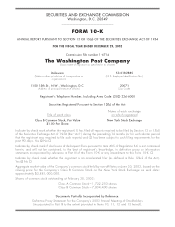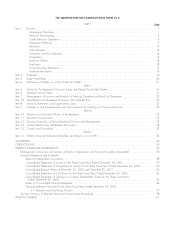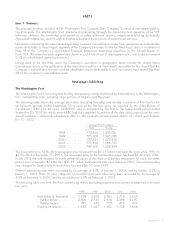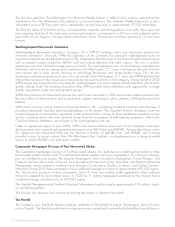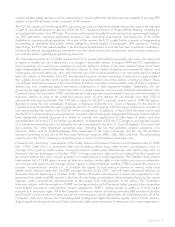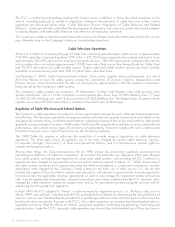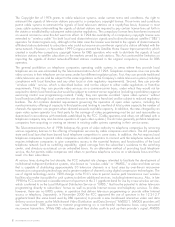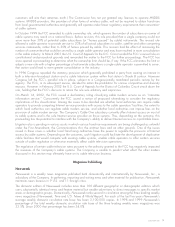Washington Post 2002 Annual Report Download - page 10
Download and view the complete annual report
Please find page 10 of the 2002 Washington Post annual report below. You can navigate through the pages in the report by either clicking on the pages listed below, or by using the keyword search tool below to find specific information within the annual report.The Copyright Act of 1976 grants to cable television systems, under certain terms and conditions, the right to
retransmit the signals of television stations pursuant to a compulsory copyright license. Those terms and conditions
permit cable systems to retransmit the signals of local television stations on a royalty-free basis; however in most
cases cable systems retransmitting the signals of distant stations are required to pay certain license fees set forth in
the statute or established by subsequent administrative regulations. The compulsory license fees have been increased
on several occasions since this Act went into effect. In 1994 the availability of a compulsory copyright license was
extended to ‘‘wireless cable’’ for both local and distant television signals and to direct broadcast satellite (‘‘DBS’’)
operators for distant signals only, although in the latter case the license was limited to the signals of distant network-
affiliated stations delivered to subscribers who could not receive an over-the-air signal of a station affiliated with the
same network. However, in November 1999 Congress enacted the Satellite Home Viewer Improvement Act, which
created a royalty-free compulsory copyright license for DBS operators who wish to distribute the signals of local
television stations to satellite subscribers in the markets served by such stations. This Act continued the limitation on
importing the signals of distant network-affiliated stations contained in the original compulsory license for DBS
operators.
The general prohibition on telephone companies operating cable systems in areas where they provide local
telephone service was eliminated by the Telecommunications Act of 1996. Telephone companies now can provide
video services in their telephone service areas under four different regulatory plans. First, they can provide traditional
cable television service and be subject to the same regulations as the Company’s cable television systems (including
compliance with local franchise and any other local or state regulatory requirements). Second, they can provide
‘‘wireless cable’’ service, which is described below, and not be subject to either cable regulations or franchise
requirements. Third, they can provide video services on a common-carrier basis, under which they would not be
required to obtain local franchises but would be subject to common-carrier regulation (including a prohibition against
exercising control over programming content). Finally, they can operate so-called ‘‘open video systems’’ without
local franchises (although local communities can choose to require a franchise) and be subject to reduced regulatory
burdens. The Act contains detailed requirements governing the operation of open video systems, including the
nondiscriminatory offering of capacity to third parties and limiting to one-third of total system capacity the number of
channels the operator can program when demand exceeds available capacity. In addition, the rates charged by an
open video system operator to a third party for the carriage of video programming must be just and reasonable as
determined in accordance with standards established by the FCC. (Cable operators and others not affiliated with a
telephone company may also become operators of open video systems.) The Act also generally prohibits telephone
companies from acquiring or owning an interest in existing cable systems operating in their service areas.
The Telecommunications Act of 1996 balances this grant of video authority to telephone companies by removing
various regulatory barriers to the offering of telephone services by cable companies and others. The Act preempts
state and local laws that have barred local telephone competition in some states. In addition, the Act requires local
telephone companies to permit cable companies and other competitors to connect with the telephone network and
requires telephone companies to give competitors access to the essential features and functionalities of the local
telephone network (such as switching capability, signal carriage from the subscriber’s residence to the switching
center, and directory assistance) on an unbundled basis. As an alternative method of providing local telephone
service, the Act permits cable companies and others to purchase telephone service on a wholesale basis and then
resell it to their subscribers.
At various times during the last decade, the FCC adopted rule changes intended to facilitate the development of
multichannel multipoint distribution systems, also known as ‘‘wireless cable’’ or ‘‘MMDS,’’ a video and data service
that is capable of distributing approximately 30 television channels in a local area by over-the-air microwave
transmission using analog technology and a greater number of channels using digital compression technologies. The
use of digital technology and a 1998 change in the FCC’s rules to permit reverse path transmission over wireless
facilities also make it possible for such systems to deliver additional services, including Internet access. Also, in late
1998 the FCC auctioned a sizeable amount of spectrum in the 31 gigahertz band for use by a new wireless service,
which is referred to as the Local Multipoint Distribution Service or ‘‘LMDS,’’ that has the potential to deliver television
programming directly to subscribers’ homes as well as provide Internet access and telephony services. To date,
however, there are no LMDS systems in operation that deliver television programming or provide either Internet
access or telephony. Separately, in November 2000 the FCC approved the use of spectrum in the 12.2-12.7
gigahertz band (the same band used by DBS operators) to provide a new land-based interactive video and data
delivery service known as the Multichannel Video Distribution and Data Service (‘‘MVDDS’’). MVDDS providers will
use ‘‘reharvested’’ DBS spectrum to transmit programming on a non-harmful interference basis using terrestrial
microwave transmitters. (While DBS subscribers point their dishes south to pick up their provider’s signal, MVDDS
8THE WASHINGTON POST COMPANY

